February 4-7, 2019 - Orlando, Florida
Overcoming Barriers to Digital Transformation
In recent years, much of the content at ARC Advisory Group’s annual Industry Forum in Orlando, Florida has revolved around IT/OT convergence and the digital transformation of industry, infrastructure, and cities.
As we’ve learned, digital transformation can be a challenging, if necessary, journey. At each year’s Forum, we learn more about how pioneering companies are overcoming these challenges and the associated operational and business benefits. This year, one of the key Forum takeaways was that culture, rather than technology, is often the major barrier on the journey to digital transformation. Other discussion threads centered around cybersecurity and data ownership.
More than 950 Attendees, 300 Companies, and 200 Speakers
Once again, this year’s Forum set record attendance with more than 950 participants from 20 countries representing more than 300 companies. A record number of corporate sponsors also helped make this annual event possible. Many industry association and media sponsors also participated. This year’s Forum featured nine topical programs hosted in six tracks for a total of 55 different sessions and workshops. More than 200 distinguished presenters and panel participants shared their insights, experiences, and concerns.
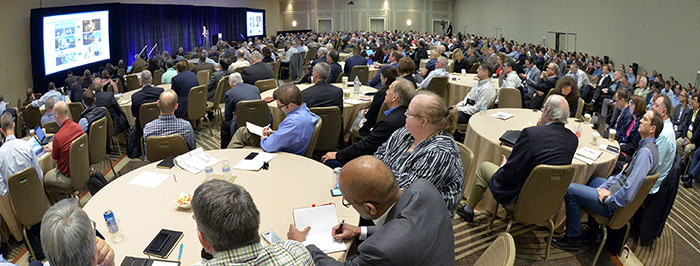
Disrupting the Commoditization of Manufacturing
The keynote presentations during Tuesday morning’s general session kicked off the formal Forum program. Nihar Satapathy, Sr. Vice President of Strategy Markets & Development at thyssenkrupp North America gave a compelling presentation entitled, “Journey Through Manufacturing 4.0: Disrupting the Commoditization of Manufacturing.” A diversified, approximately $10.5 billion industrial group, thyssenkrupp has more than 40 manufacturing-centered businesses and 24,000 employees.
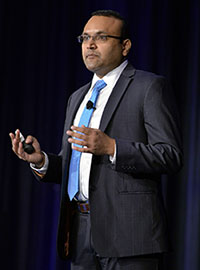 As the title of his presentation suggests, Mr. Satapathy believes that well-established companies such as thyssenkrupp need to transform digitally to avoid the risk of becoming commoditized. “For us, innovation is at the center of our digital transformation. We like to engineer the solutions of tomorrow with our customers. But how does a 200 year old company do this?”
As the title of his presentation suggests, Mr. Satapathy believes that well-established companies such as thyssenkrupp need to transform digitally to avoid the risk of becoming commoditized. “For us, innovation is at the center of our digital transformation. We like to engineer the solutions of tomorrow with our customers. But how does a 200 year old company do this?”
New technology trends and business models are impacting the company’s place in the value chain, threatening commoditization. To compete in this environment, thyssenkrupp developed the ability to apply a broad range of digital tools to increase customer value add.
Mr. Satapathy gave use cases in three different areas of the company’s business: elevators, automotive, and home stair lifts. Each demonstrates innovative ways for the company to differentiate its offerings.
- MAX, thyssenkrupp’s predictive maintenance solution for its elevators, leverages remote IoT-connected sensors, analytics, and the company’s core competencies in this area. The solution turns every elevator into a communication device and uses the data collected to track and improve reliability.
- The company’s digital twin solution for automotive manufacturing mimics what’s happening on assembly lines in near real time to improve performance and speed any needed changes to those lines. In this and other applications, data gives thyssenkrupp the capability to control its value stream.
- The traditional sales/design/manufacture/install process for stair lifts usually takes several months. After developing an innovative digital solution the company can now manufacture and install a custom-designed stair lift in weeks, rather than months. This new customer-centric digital solution has helped thyssenkrupp double its stairlift business.
Mr. Satapathy concluded his keynote by summarizing the lessons learned:
- Digitalization is inevitable – embrace it, the sooner the better
- Technologies are available – find relevant business cases to create customer value
- Partnerships – leverage relationships and be open for new ways of engagement
- Stay the course – it will be worth it, it will be game changing!
- It’s a journey – prepare for the long haul with time, effort, and resources
Building Digital DNA at Scale
Larry Megan, Director at Praxair Digital, began his keynote, “Building DigitalDNA@Scale,” by pointing out that it can be hard to sort out the hype from the reality. “You hear about the promise; but we all have technology and organizational debt.” Digital transformation means different things to different companies and different functions. Mr. Megan stressed that “It’s important to know your target. Don’t get hung up on the definitions, just what you need to accomplish.”
He recommended developing a digital strategy based on:
- Never starting with technology
- Feeling your customers’ experience (internal and external)
- Building a foundational platform to support scaling, and
- Emphasizing products over projects (should be both sustainable and improvable over time)
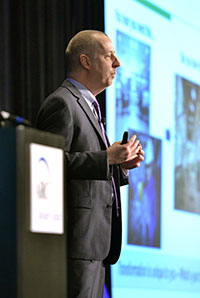 He also stressed the importance of knowing your path to value. In Praxair’s case, this included real-time visibility, granularity, reduced friction, and ecosystem connectivity. “It’s not about being more digital, but about changing how work gets done,” he said.
He also stressed the importance of knowing your path to value. In Praxair’s case, this included real-time visibility, granularity, reduced friction, and ecosystem connectivity. “It’s not about being more digital, but about changing how work gets done,” he said.
Praxair has a variety of businesses with diverse business and digital strategies, including its onsite industrial gas supply business that serves steel mills and other process plants.
The company developed a digital predictive reliability strategy for its many large compressors. Starting with a global foundation of a historian and CMMS, the company is installing new sensors to get the needed data to the limited number of experts available to support the company’s many facilities. “We’re trying to do more with data at the edge,” Mr. Megan explained.
Praxair worked with the US Department of Energy to improve energy efficiency by using infrared sensors to measure heat losses around the perimeters of its large furnaces. Using its historian as a global foundation, the company’s digital strategy for energy efficiency will focus on developing low-cost sensors/controls and utilizing open platforms.
To help develop the digital culture needed for effective digital transformation, he advised Forum participants to invest in initiatives that change the company, establish leadership to identify and drive digital opportunities, and communicate success stories to energize the organization.
Planning for Digital Transformation
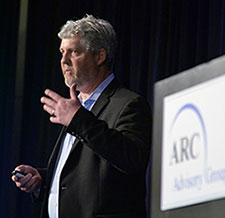 In his general session presentation, Mike Guilfoyle, Research Director at ARC Advisory Group, provided some perspectives on planning for digital transformation based on ARC’s research, consulting, and collaboration activities in this area. Not surprisingly, many of these thoughts resonated with those provided by the previous keynotes.
In his general session presentation, Mike Guilfoyle, Research Director at ARC Advisory Group, provided some perspectives on planning for digital transformation based on ARC’s research, consulting, and collaboration activities in this area. Not surprisingly, many of these thoughts resonated with those provided by the previous keynotes.
As Mike explained, “Whether it’s disruptive technology, ongoing market innovation, multi-billion-dollar governmental pushes, or some combination of all three; all industries and populations are feeling pressure to transform.” This makes it clear that every industrial- and infrastructure-related organization and municipality needs to understand how to embrace and execute digital transformation.
What makes careful planning so critical is that organizations expect to reap massive, game-changing benefits from digital transformation. Yet, as Mike explained, many continue to be confounded when it comes to ROI and scale. He referred to statistics that indicate that more than 80 percent of industrial companies are now undertaking digital transformation initiatives, but less than 11 percent are seeing sustainable success. “Many industrial users suffer from ‘pilot paralysis.’ Others are unable to scale up to maximize the benefits,” he explained. “I don’t need machine learning to know that something is wrong with this picture.”
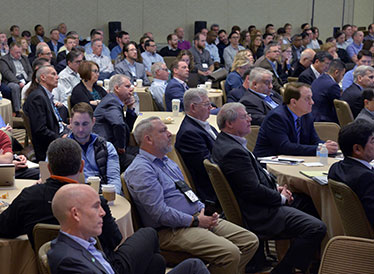 Mike explained that common missteps include: numerous possibilities without direction, pursuit of technology, and managing cultural impediments. All are related.
Mike explained that common missteps include: numerous possibilities without direction, pursuit of technology, and managing cultural impediments. All are related.
Digital transformation offers a plethora of possibilities, but much less direction. This leads to the pursuit of technology for technology’s sake. And, of course, as he emphasized, “The cultural barriers, the elephant in the room, underpin all others. No one wants to take on the cultural barriers to change,” he said.
“Digital transformation initiatives must find a way to create connective tissue between strategic objectives and the specifics of each project executed. This enables organizational adherence to a cohesive business strategy at all levels and throughout the entire transformation process.” According to Mike, this ensures that:
- Priorities can be established
- Decisions have rationale and the people that make them have the authority to carry them out
- Management is fully informed by operational realities for buy-in, scale, and long-term success
This connective tissue between strategy and how projects are executed also accounts for people, the role they need to fill, and how they derive purpose and value as change occurs.
To ensure this alignment, ARC recommends a three-step process for our client’s that are planning digital transformations:
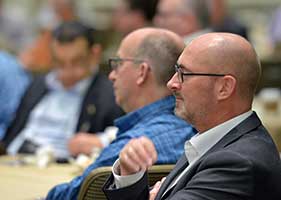 Assess your organizational maturity and capacity for change
Assess your organizational maturity and capacity for change- Determine where to start applying technologies. This provides a meaningful way to develop a framework to consider the role of technology and pilots in terms of how to select, deploy, and scale them within a strategic framework
- Determine how to execute based on your current readiness to align the framework to tactics
Mike noted that many organizations would prefer to skip step one because that’s where all the cultural barriers exist, but that this would be a huge mistake.
Executive Panel Discussion
Following these three keynote addresses, ARC CEO Andy Chatha invited Raj Batra, President of Digital Factory at Siemens, Craig Hayman, CEO of AVEVA, and Patrick Holcomb, Chief Strategy Officer and Executive Vice President of Hexagon PPM to say a few words about how their respective companies are addressing these key issues before participating in a panel discussion with the keynote presenters.
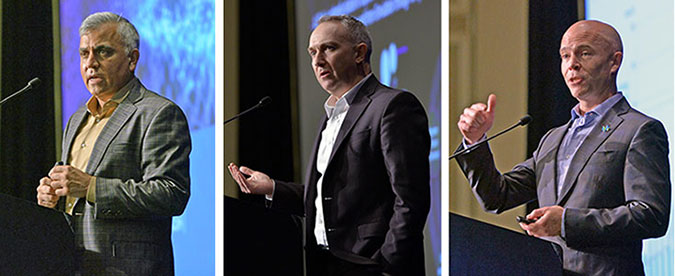
The panelists then addressed some pointed questions from both Andy and the audience. The panel discussion was followed by three full days of topical sessions and networking opportunities, including an enjoyable Wednesday evening reception at nearby SeaWorld's Key West and Antarctica Empire of the Penguin, hosted by Microsoft, just one of the Forum’s many corporate, association, and media sponsors.
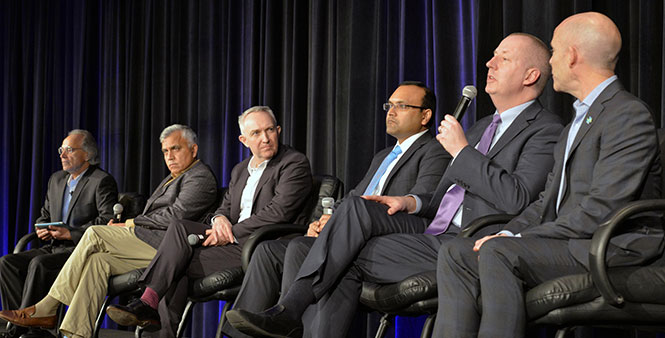
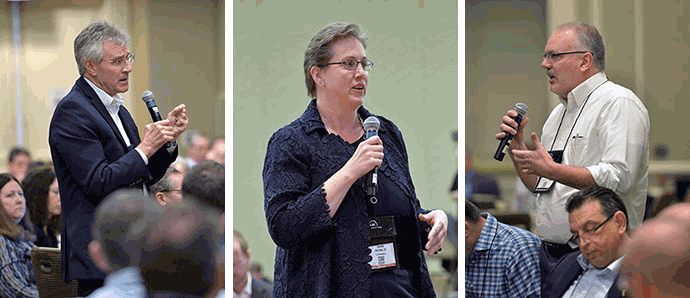
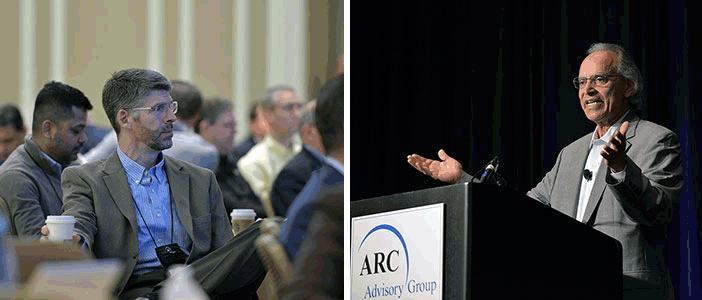
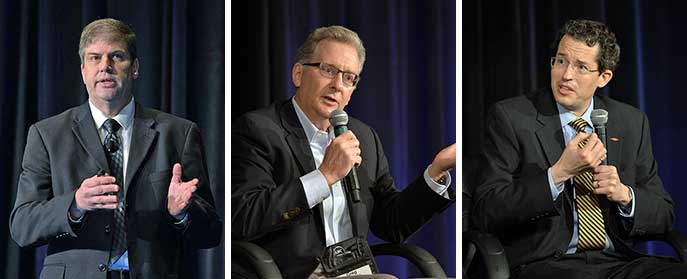
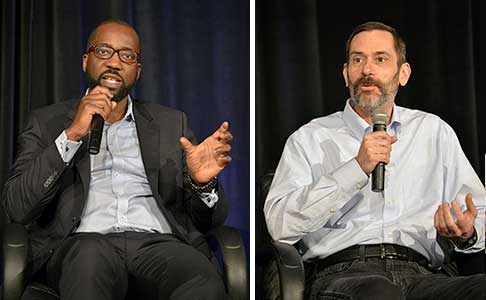
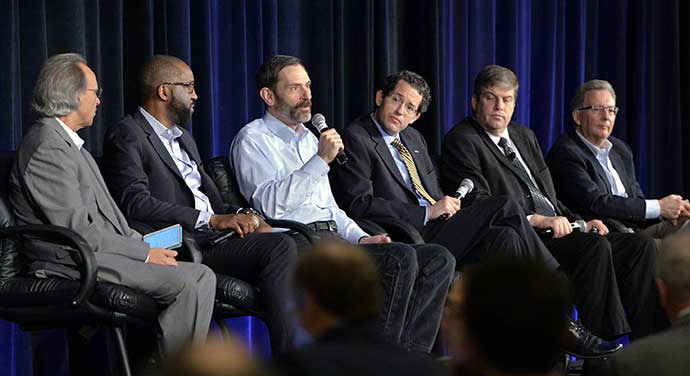
Most industrial companies still tend to make decisions based on habitual ways of doing things, tribal knowledge, rules-of-thumb, and the opinions of in-house experts. But leading companies are moving to an information-driven culture and business model in which all decisions are made based on analysis of operations and business process data. Throughout the organization, these companies employ software to collect, contextualize, visualize, and analyze data to gain new insights. The common question is, “What does the data tell us?” Armed with new insights, organizations can anticipate changes and drive better business results.
It is clear that the use of analytics in industrial companies is growing rapidly. With the industrial space becoming much more dynamic, manufacturers are turning to advanced analytics and machine learning to support predictive and prescriptive solutions. More companies are pursuing analytics solutions and more employees throughout the enterprise want more and better decision tools. And the increasing focus on Smart Manufacturing, Industrie 4.0 (I4.0), and Industrial Internet of Things (IIoT) is driving demand for predictive maintenance and operating performance improvement solutions, which rely on advanced analytics.
This program will:
- Cut through the confusion surrounding 'analytics' in the industrial space
- Provide a useful conceptual framework for differentiating modern analytics platforms from previous approaches
- Highlight new technologies, platforms, architectures, and processes
- Present case studies and examples from early adopters of new analytics systems
- Provide industrial companies the information they need to begin their own analytics journey
Asset Performance Management incorporates Industrial IoT (IIoT) and new analytics solutions like machine learning. It uses information from production management, control systems, and asset management applications to provide new opportunities to optimize asset availability and operational performance. This optimization goes beyond functional silos and occurs between silos where significant inefficiency, waste, and sometimes dysfunction often reside.
Balancing the objectives of operations for on-time delivery, volume, and quality with those of maintenance for asset availability, longevity, and reliability requires sharing information and harmonizing these objectives with the goals of the enterprise. New information technologies provide functionality to intensify cross-functional collaboration, business process improvements, and higher levels of performance to achieve asset performance management (APM) excellence.
The ability to interact with equipment – like a variety of devices on a single site, or widely dispersed machines – presents new opportunities for industrial companies, utilities, and equipment suppliers. These networks provide a new “connected ecosystem” of equipment manufacturers, systems integrators, and end users. Some manufacturers and utilities have begun adopting these technologies.
Those attending this asset performance management program will learn what was successful, and gain insights into what is next. The objective is to make fact-based decisions using reliable information that aligns with the organization’s objectives. An APM strategy helps ensure the best possible returns on capital investments over the lifecycle of the asset. If you are involved in operations, maintenance, or industrial IT, you will want to attend these program sessions.
We have entered a period of intense innovation in industrial automation. In the areas of high value-added manufacturing there is growing global competition. Countries with developed economies want to maintain and grow their existing competitive advantages and support their exporting industries. Countries with developing economies want to improve their competitiveness as well.
This competition is, in part, taking the form of national initiatives to improve manufacturing competitiveness. These initiatives are found in Germany, the US, Japan, Korea, and China. In the US the Industrial Internet Consortium has formed. Platform Industrie 4.0 is the German initiative; the “4.0” referring to a 4th industrial revolution (following steam, mass production, and IT). This can be thought of as a set of new technologies that are fusing the physical, digital, and biological worlds, and impacting all disciplines, economies and industries.
Some of the topics that will be covered in the sessions for this program include:
FDI, OPC UA, and Ethernet for Process Field Devices
The FieldComm Group and the OPC Foundation will explain and demonstrate their newest technologies for process automation. This will be a multi-vendor/multi‐protocol device-to-cloud demonstration of both FDI and OPC UA. Also, as part of a new supplier consortium, FieldComm Group will explain its conformance program for devices that will use the future 2‐wire Ethernet standard now in development by the IEEE 802.3cg committee. This 2019 standard will enable high speed communication to process field devices over distances as long as 1 kM.
The Open Process Automation Forum: The Latest Update
The Open Group’s Open Process Automation Forum is noteworthy for several reasons. First, because of its genesis within ExxonMobil, a leading international oil company with a long reputation for operational excellence. Second, because the products of this program will be technologically quite different from the process automation systems used today. Third, because the value chain envisioned for this program is also quite different from the way the process automation market works today. The latest developments in this initiative will be presented and discussed.
Industrial Automation and the Industrie 4.0/Industrial Internet Initiatives
What will be the impact on manufacturing and automation of these major national initiatives? How will the process industries, discrete manufacturers, and automation suppliers adapt and change their products in response to these programs? What are thought leaders in Europe and North America doing now and planning for the next few years?
TSN, OPC UA, and Future Industrial Automation
Time Sensitive Networking, or TSN, carries huge implications for industrial automation, for existing industrial Ethernet protocols, as well as for OPC UA and for all types of industrial middleware. TSN is an effort to bring much higher and more adjustable quality of service to standardized networks. TSN is needed for “network convergence”; when a single physical network replaces multiple dedicated-function networks. In such cases, network traffic needs to be managed so that the applications using the single converged network continue to experience their normal quality of service. Where are the biggest cases for network convergence today? The largest unit volume opportunity is for converged networks in automotive on-car applications for future smart and autonomous cars and in industrial automation.
Industrial Software Defined Networks
Technologies of software-defined networking (SDN) that have recently been applied in actual industrial control systems are quite promising in that they may deliver substantial improvements in the properties of networks of both new and existing industrial control systems and IIoT infrastructure. These networks promise greater security, performance, and even ease of device mobility. ARC plans to have several end users report on their experiences.
Autonomy and intelligence embedded pervasively in automation equipment is one of the key attributes to realization of connected smart machinery. Connected smart machinery is important in virtually every application imaginable, but is even more valuable in cases where there is limited communications. Machinery that analyzes and compresses large data sets are essential to ensuring that the data traffic on the Internet does not overwhelm the system or data can be analyzed local to the device. The connected smart machine will require not just more sensors, but also more intelligent sensors. Sensors must perform more sophisticated signal processing “at the edge” to provide accurate signals that filter out the noise before it gets to the automation system.
In this program, machine builders employing intelligent sensors into the machinery to perform complex condition monitoring algorithms into automation systems will be highlighted. Key topics for discussion include:
- Creating new maintenance service revenue streams for machine builders
- Development of equipment protection algorithms that increase resilience of machinery to stay operational for much longer periods of time.
- Adaptive control algorithms allowing systems to operate over a wider range.
- Predictive condition monitoring systems that use real-time control algorithms to provide a new level of maintenance information.
- Exploring the potential of the Industrial Internet of Things (IIoT) to combine the benefits of multivariate analysis, predictive modeling, and inferential information to preempt abnormal situations.
Challenges continue to grow for people responsible for the cybersecurity and safety of operational technology. Broad OT deployments are expanding the use cases requiring protection. Resource shortages and siloed efforts are undermining the effectiveness of established defenses. Blurring boundaries between IT, OT, and IoT are increasing the need for more integrated, collaborative cybersecurity strategies. Attacks on protective equipment have raised the urgency of close coordination between cybersecurity and safety efforts.
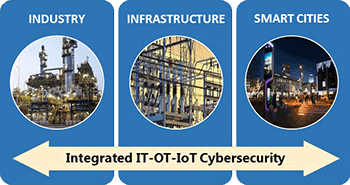 Industrial plants and infrastructure systems need secure control systems to ensure safe, reliable operation. But they remain at risk of cybersecurity attacks. Many organizations lack the internal resources and expertise to sustain defenses, and safe, secure methods for external support. Growing use of cloud-based solutions are undermining the ability of in-house teams to govern security practices. Deployments of IIoT strategies are proceeding without solutions for critical issues like secure devices and vendor support. Segregating cybersecurity responsibilities by technology is no longer a sustainable approach. Organizations need integrated strategies that combine IT, OT, and IoT security.
Industrial plants and infrastructure systems need secure control systems to ensure safe, reliable operation. But they remain at risk of cybersecurity attacks. Many organizations lack the internal resources and expertise to sustain defenses, and safe, secure methods for external support. Growing use of cloud-based solutions are undermining the ability of in-house teams to govern security practices. Deployments of IIoT strategies are proceeding without solutions for critical issues like secure devices and vendor support. Segregating cybersecurity responsibilities by technology is no longer a sustainable approach. Organizations need integrated strategies that combine IT, OT, and IoT security.
Widespread use of operational technologies in smart cities make them susceptible to similar risks. Compromised systems jeopardize citizen safety, business continuity, and effective delivery of critical services like power, water, and sewage. To avoid incidents, smart city planners need people who understand operational technology and the associated cybersecurity and safety challenges.
Safety is a major concern in the design of every OT system and today this needs to consider cybersecurity. Redundancy and protective devices used to address conventional risks are already being targeted by cyber-attacks. Managing these additional safety risks requires close coordination between safety and cybersecurity efforts.
The Cybersecurity and Safety Forum program explores these issues through informative workshops, panel discussions, and case study presentations. It is the ideal venue to learn what others are doing, how they are doing it, and the benefits they are achieving. Attendees also have ample opportunities to discuss their unique challenges with peers, researchers, educators, service providers, and solution providers.
This program is unique. Other conferences discuss cybersecurity from a single perspective, like IT or OT. The safety implications of OT cybersecurity are not even on their agendas. ARC’s program is the only event that brings together people who understand all the cybersecurity and safety challenges of industry, infrastructure, and smart city organizations. Attendees leave armed with the information they need to make significant improvements in their cybersecurity programs.
Stakeholders in IT, automation, operations, safety, product development, business improvement, and city planning efforts can all benefit from this program. They will gain a solid understanding of the challenges and the actions needed to avoid major cybersecurity incidents.
Industrial Internet platforms are emerging as pivotal, value-added components of the Industrial Internet of Things (IIoT) architecture. These platforms add incremental value by functioning not only as the glue linking connected industrial devices to higher level performance-enhancing applications, but also as the execution environment for the applications themselves.
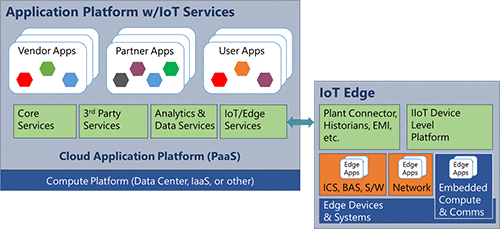 Industrial Internet platforms play an integral role in analytics, big data, remote asset monitoring, performance management, decision support, universal visualization, and the value chains for connected products and products-as-a-service. The ability of these applications to access, analyze, and process industrial data is central to the IIoT value proposition.
Industrial Internet platforms play an integral role in analytics, big data, remote asset monitoring, performance management, decision support, universal visualization, and the value chains for connected products and products-as-a-service. The ability of these applications to access, analyze, and process industrial data is central to the IIoT value proposition.
Industrial Internet platforms architecturally reside between intelligent devices and higher levels of the enterprise architecture. Device connectivity platforms monitor, collect, process, and transmit data from a variety of intelligent sensors, devices, machines, products, and other assets to higher levels of the architecture, while analytics, big data, machine learning, and numerous other applications that deliver incremental process improvements typically reside in enterprise-level platforms.
This program will look at the central role of Industrial Internet platforms in the emerging Industrial Internet of Things and how to use them to achieve incremental business benefit.
The IoT network edge has emerged as a primary vehicle for delivering incremental business value via internet-enabled business strategies such as the Industrial Internet of Things (IIoT), Industrie 4.0 (I4.0), and Smart Cities and Infrastructure.
Escalating demands to feed information from data-rich intelligent edge devices to the cloud is one of the most pressing issues facing OT and IT professionals in the era of internet-enabled business strategies. Standard options include support of common API or protocols, but cloud-based agents themselves are migrating into network edge devices. These agents are increasingly viewed as not only vehicles for closer edge-to-cloud integration, but also as platforms for edge computing applications that execute locally, offloading processing from the cloud and providing enhanced security and closer to real time performance.
This program will highlight current and prospective demands on both network edge infrastructure, such as gateways, routers, and switches, as well as smart end devices that function as edge nodes in the IoT architecture. In addition, this program will focus on edge to cloud integration options with an emphasis on embedded cloud integration and edge computing.
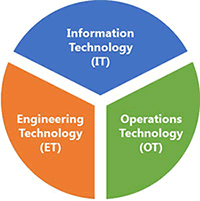 An important enabler for innovation in industrial companies is the convergence of IT (Information Technology at the enterprise level), OT (Operations Technology, the information and automation technologies employed in the plant), and ET (Engineering Technology, the newer technologies that create virtual models). IT/OT/ET convergence is among the drivers of the digital transformation that leading companies are embarking upon. A wide range of technologies, such as Ethernet/Wi-Fi, virtualization, cloud, SaaS, analytics, Big Data, mobile, social, modeling, augmented reality, machine learning, remote monitoring, and digital twin are now being employed in industrial operations to improve operating performance, create a virtual environment, or introduce the Industrial Internet of Things. But the big payoff comes when companies begin to operate in new, collaborative ways across the whole of the enterprise.
An important enabler for innovation in industrial companies is the convergence of IT (Information Technology at the enterprise level), OT (Operations Technology, the information and automation technologies employed in the plant), and ET (Engineering Technology, the newer technologies that create virtual models). IT/OT/ET convergence is among the drivers of the digital transformation that leading companies are embarking upon. A wide range of technologies, such as Ethernet/Wi-Fi, virtualization, cloud, SaaS, analytics, Big Data, mobile, social, modeling, augmented reality, machine learning, remote monitoring, and digital twin are now being employed in industrial operations to improve operating performance, create a virtual environment, or introduce the Industrial Internet of Things. But the big payoff comes when companies begin to operate in new, collaborative ways across the whole of the enterprise.
This program features speakers talking about how they utilized the IT/OT/ET enablers of digitization and innovation to improve performance in their production operations and throughout their organizations.
The concept of a smart city is not new, but it is still nascent and the definition remains quite heterogeneous. Broadly, a smart city is connected, intelligent, and optimized by a municipality to reduce costs, increase safety, attract investment, be sustainable, and enhance livability. To get there will require smart governance, the education of a smart workforce and smart citizens, the digital transformation of assets, and the deployment of sensor networks with ubiquitous multimodal connectivity.
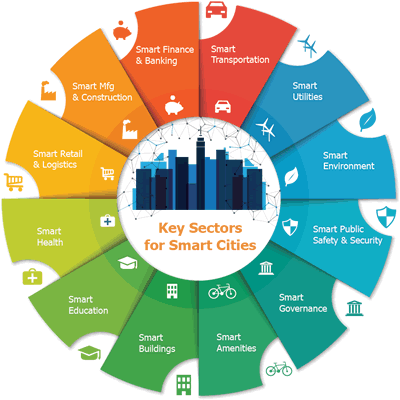 As computing power, bandwidth, and the cost of microprocessor electronics and sensors all approach zero, the ability for municipalities to deploy massive wide-area networks of intelligent devices is slowly becoming reality. Smart cities present tremendous opportunities for industrial IoT vendors, but the technical challenges, vast number of players in this ecosystem, and the fact that it bridges private, public, and consumer realms makes navigating and succeeding in this market a challenge. Cybersecurity, connectivity, and working with municipal bureaucracy remain the biggest challenges, but other obstacles include exponential data volume growth, data cleansing speed, the need to go from cloud to edge architectures, quantifying results, interoperability, and human fears/resistance to transformational change such as AI.
As computing power, bandwidth, and the cost of microprocessor electronics and sensors all approach zero, the ability for municipalities to deploy massive wide-area networks of intelligent devices is slowly becoming reality. Smart cities present tremendous opportunities for industrial IoT vendors, but the technical challenges, vast number of players in this ecosystem, and the fact that it bridges private, public, and consumer realms makes navigating and succeeding in this market a challenge. Cybersecurity, connectivity, and working with municipal bureaucracy remain the biggest challenges, but other obstacles include exponential data volume growth, data cleansing speed, the need to go from cloud to edge architectures, quantifying results, interoperability, and human fears/resistance to transformational change such as AI.
ARC has identified 12 key smart city application sectors: Smart Transportation, Smart Utilities, Smart Environment, Smart Public Safety and Security, Smart Governance, Smart Buildings, Smart Education, Smart Health, Smart Retail and Logistics, Smart Manufacturing and Construction, Smart Finance and Banking, and Smart Amenities. This program will feature expert panels and case study presentations showcasing successful deployments of key smart city IIoT technologies. Topics for discussion include:
- Cyber-secure smart city ecosystems
- Smart utilities: Self-healing grids and smart water networks
- Intelligent transportation and traffic systems
- Moving from centralized to edge architectures
- Lighting networks as the IoT backbone for smart cities and buildings
- Advanced visualization including Digital Twin & AR/MR/VR platforms for cities and buildings
- Machine learning and artificial intelligence for cities and buildings
- Leading-edge enablement technologies such as SD-WAN, HD video analytics, and extreme data processing at the edge
It was an honor and pleasure to be invited to speak at the ARC event. I was impressed with the level of knowledge I was exposed to at this conference; this will become an annual event for me. A sincere thank you to ARC for organizing a "WOW" event.
Marty Martin
Director, Process Control Technology

ARC Advisory Group industry events are extremely valuable (to Saudi Aramco). ARC is the barometer for our industry.
Abdullah Al-Khalifah
Senior Engineering Consultant

For me, since I’m from the pharma industry, coming to the ARC forum gives me a chance to interact with folks in like roles from different industries. It’s been very valuable for me to bring ideas and new connections back to my company and apply them to our business.
Kevin Fulton
Director of Engineering

It was a high honor for me to participate [at ARC's Forum] on behalf of the City of Orlando!
Charles Ramdatt
Director, Smart Cities and Special Projects

Monday, February 4 - Pre-Forum Workshops
| 8:30 AM | Workshop Sessions |
| 10:00 AM | Break |
| 10:30 AM | Workshop Sessions |
| 2:00 PM | Workshop Sessions |
| 3:30 PM | Break |
| 4:00 PM | Workshop Sessions |
| 6:00 PM | Welcome Reception |
Tuesday, February 5
| 8:30 AM | Keynote Presentations |
| 10:00 AM | Break |
| 10:30 AM | Executive Panel |
| 12:00 PM | Lunch |
| 2:00 PM | Concurrent Track Sessions |
| 3:30 PM | Break |
| 4:00 PM | Concurrent Track Sessions |
| 6:00 PM | Evening Reception |
Wednesday, February 6
| 8:30 AM | Keynote and Executive Panel |
| 10:00 AM | Break |
| 10:30 AM | Concurrent Track Sessions |
| 12:00 PM | Lunch |
| 2:00 PM | Concurrent Track Sessions |
| 3:30 PM | Break |
| 4:00 PM | Concurrent Track Sessions |
| 6:00 PM | Evening Reception |
Thursday, February 7
| 8:30 AM | Concurrent Track Sessions |
| 10:00 AM | Break |
| 10:30 AM | Concurrent Track Sessions |
| 12:00 PM | Forum Ends with Boxed Lunches |
Featured Keynote Speakers
The following executives will give the Forum's Keynote Presentations.
Nihar Satapathy
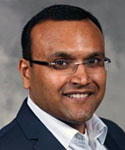 Sr. Vice President, Strategy, Markets & Development
Sr. Vice President, Strategy, Markets & Development
thyssenkrupp North America
Nihar is responsible for providing strategic analysis of key markets and competitors to determine future business opportunities for thyssenkrupp within the North America region. His primary objective is to work with thyssenkrupp’s various businesses in the US, Canada, and Mexico to help drive the topline and margin growth of the company. Prior to joining thyssenkrupp, Nihar worked at The Boston Consulting Group (BCG) for more than six years, where he helped clients across various industries on strategic growth initiatives, organizational development, and operational effectiveness topics. During his tenure with BCG, he earned two Polaris awards for outstanding client contribution and served in positions of increasing responsibility from Consultant to Project Leader to Principal. Prior to joining BCG, Nihar gained more than seven years of experience in supply chain management within the automotive, healthcare, and technology sectors.
Larry Megan
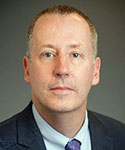 Director
Director
Praxair Digital
The Praxair Digital team is chartered with enabling digital innovation across the enterprise, including Praxair’s manufacturing operations, supply chains, and business processes, as well as creating a greater external digital presence. Larry joined Praxair in 1993, later becoming an R&D manager and Corporate Fellow. He holds multiple US patents and has co-authored 13 peer reviewed journal articles. He received AIChE’s Computing Practice award in 2015 and the National Academy of Engineering Eminent Young Engineer award in 2006, and multiple internal awards. He is a member of the University at Buffalo (UB) Industrial Engineering Advisory Board, the Buffalo Manufacturing Works Founders Board, and is actively involved in collaborative efforts between UB and the Buffalo Public Schools to improve science and math education.
David Kramer
 Smart Living / Internet of Things Research Lead
Smart Living / Internet of Things Research Lead
Ford Motor Company
David has had a diverse career in automotive, aerospace, education, and pharmaceutical serving in a variety of roles including engineering, manufacturing, supply chain management, and information technology. He is a serial inventor, writer, artist, and has been involved in a number of startups and entrepreneurial endeavors. Currently he is working for Ford Motor Company as the Smart Living/Internet of Things Research Lead.
Innovations Showcase
New industry solutions are on display at the Innovations Showcase. The Showcase provides an excellent opportunity for executives to assess the potential for emerging applications in production management, interoperability, virtual manufacturing, process improvement, asset management, operations management, supply chain synchronization, and more. Exhibits have application scenarios for attendees to see how emerging technologies are applied to help solve issues across all industries.
The Showcase is open during the Monday Evening Reception and during breakfasts, breaks, and lunches. It is held adjacent to the forum where refreshments are served.
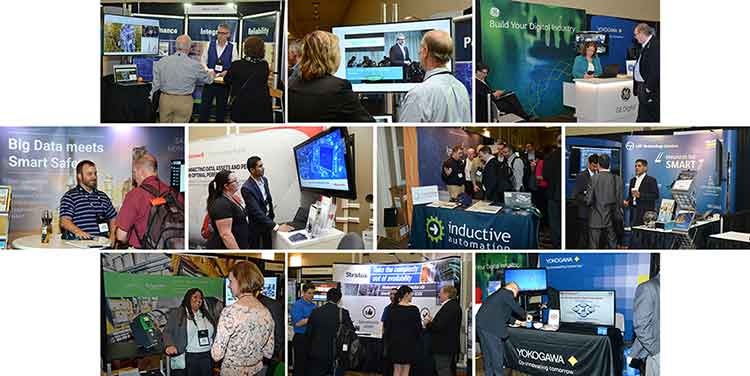
Location
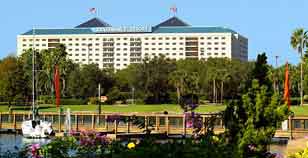 The Forum is held at the Renaissance Orlando Hotel in Orlando, Florida.
The Forum is held at the Renaissance Orlando Hotel in Orlando, Florida.
Renaissance Orlando at SeaWorld
6677 Sea Harbor Drive
Orlando, Florida 32821
renaissanceseaworldorlando.com
The Renaissance is just a short shuttle or taxi ride from the most popular Orlando attractions and within easy access of Orlando airports. Hotel amenities include complimentary 24 hour fitness center use; transportation to SeaWorld Orlando, Discovery Cove, Aquatica, and Universal Studios Orlando based on shuttle schedule; and public area wireless Internet.
Orlando Visiting Information
Please contact Orlando's Visitor Information Center at 407-363-5874, www.visitorlando.com, for information regarding current events in Orlando. For discounted attractions in Orlando, please visit Orlando Convention Aid website. Their on-line travel guide offers discounts to restaurants, golf, attractions, nightlife, shopping, and more, including making dinner reservations for you.
Previous Attendees
The following companies have attended recent ARC forums:
Aerotech
Agilent Technologies
Air Liquide
Akzo Nobel
Alliance Pipeline
AMEC Natural Resources
Anglo American
Archer Daniels Midland
Areva
Axiall
Azbil
Baker Hughes
Beckhoff Automation
BHP Billiton
Blackrock
BorgWarner
Bosch Rexroth
Brady
C-Labs
Cal-Amp
Cambell Soup
Cenovus Energy
CF Industries
China Yangzte Power
Church & Dwight
Comau
Connacher Oil and Gas
Consumers Energy
Cummins
Danaher
Dell
Descartes Systems Group
Dominion Virginia Power
Dow Kokam
DTE Energy
Duke Energy
Eaton
Electro-Matic Products
Elkay Manufacturing
EMC
EQUATE Petrochemical
Festo
Flint Hills Resources
Freeport McMoran
GE Aviation
Genpact
Goodrich Petroleum
Goss International
Greater Cincinnati Water Works
Hirschmann Automation & Contro
HubHead
Independen Belgian Refinery
Inductive Automation
Industrial Defender
Industrial Evolution
Infosys
Innominate Security Technologies
Intergraph
International Paper
Iscar Metals
JHP Pharmaceuticals
John Deere
Joy Mining Machinery
KapStone
Kollmorgen
Kongsberg Oil & Gas Technologies
KUKA
L&T Infotech
Lafarge
Lakeland Electric
LifeCare Services
Lockheed Martin
Lopez Foods
LyondellBasell
M+W Automation
Manufacturing Connection
Marathon Electric
Mark Andy
Maverick Technologies
MaxGrip
Mentor Graphics
MESA
Mettler Toledo
MillerCoors
Momentive Specialty Chemicals
Morgan Stanley
Mori Seiki
Nalco Champiion
NAMUR
NEMA
North West Redwater Partnership
Northwest Analytics
NovaTech
ODVA
Okuma America
OLDI
Pacific Northwest National Lab
Palmer Foundry
Panasonic
Panduit
Paper Converting Machine
Parker Hannifin
Patti Engineering
PCN Technology
Petro Rabigh
Petrobras
Phoenix Contact
PLCopen
POSC Caesar
Profibus & Profinet International
ProSys
PTC
Public Service Co. of New Mexico
Quiet Logistics
Rackspace Hosting
Red Arrow Logistics
Rich Products
Rolls-Royce
Rotork
Ryder System
Sabic
Sabisu
SAIC
Sans Institute
Sekuworks
Shaw Power Group
Shell Exploration & Production
Skkynet Cloud Systems
Smurfit-Stone Container
Sony Electronics
Telecom Industry Assoc.
Tetra Pak
TOTAL
Toyota Motor Manufacturing
Trend Micro
U.S. Department of Energy
Universal Parks & Resorts
Vale
Valero Energy
Vallourec & Mannesmann do Brasil
VIA Information Tools
Walt Disney World
Wells Enterprises
Whirlpool
Wipro Technologies
Wurldtech Security Technologies
Xerox
Yanbu National Petrochemical
Yaskawa








